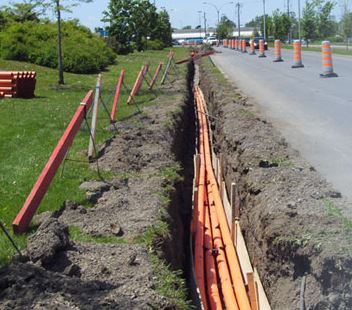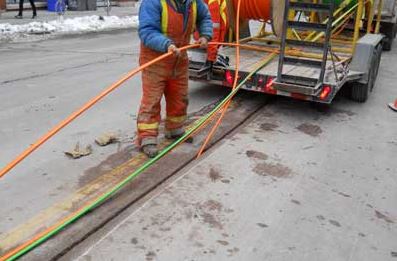Optical fibers are mechanically very different from steel and copper cables, and the techniques for installing them are therefore significantly different. Fibers are not only are extremely brittle, but also elastic to an extent. Fibers must be also be protected from tensile forces (axial), comprehensive forces and bending.
The long term transmission characteristics of optical fiber depends on the installation procedures used. Fiber laying is a specialized discipline that has to be performed by trained and experience personnel.
Ducting & Trenching
The traditional method of laying optical fibers still used in most developing countries is Ducting and Trenching. This involves creating a trench through manual or mechanized soil excavation. This approach is preferred in countries where manual labor is cheap.
Trench specifications are normally defined by local authorities and could be specified for each operator in countries with multiple operators.
The trenching process needs careful control to make sure the trench floor does not have any kinks and is uniform, and trenches do not have major bends.

Ducts are placed in the trenches and fiber is then blown through the ducts with specialized fiber blowers, using water or air. In Air Assisted Fiber Blowing, the blowers use compressed air to push fiber through ducts.
It is standard practice to lay conduits, then draw inner ducts through the conduits and finally blow the fibers through the ducts. A common conduit size is 4 inches (100mm), but 6 inch (150mm) conduits are also available. The size of the inner duct is normally 1.25 inches.
It should be noted that fiber cables should never use more than 70% of the available duct space. When 1 inch fiber cables are used, they occupy 64% of a 1.25 inch duct. Ducts are manufactured from High Density Polyethylene (HDPE). HDPE is hard, can withstand temperatures up to 120°C and have excellent resistance to alcohols, concentrated acids and bases.
Trenching
Mechanized equipment is used to create trenches in many different surfaces. This technique can be used on routes that contain asphalt surfaces such as sidewalks and roads. The technique is however not suitable for soil with cobbles or gravel, or sandy soil. This technique has an advantage over conventional cable laying methods in that it is much faster to execute. The cross-section and depth of the trench will depend on the number of ducts to be laid. While the cross-section varies between 7 and 15 cm, the depth is typically between 30 and 40 cm.
Three methods of trenching commonly used are:
- Standard
- Semi Automated
- Fully Automated
Trenching, ducting, backfill operations and cleaning are all performed simultaneously when the fully automated method is used. When the standard and semi-automated methods are however employed, the operations are not done at the same time.

